Essential Insights on 7mm Surf Gloves for Cold Water


Intro
Surfers often find themselves facing the relentless nature of oceans, especially in chillier waters where temperatures can dip alarmingly low. This is where 7mm surf gloves come into play, providing not just warmth but also crucial grip and dexterity that every wave rider needs. Many enthusiasts grapple with selecting the right pair, often overlooking the specific designs and materials that can enhance their surfing experience. But how do these gloves matter? Let's dive deeper.
Techniques and Skills
Fundamental Techniques for Beginners
For those just starting their surfing journey, understanding how to manage your gear is as vital as mastering the art of paddling and maintaining balance on a board. Wearing 7mm surf gloves may seem simple, but there’s a world of technique behind their effective use.
- Paddling Technique: When beginners don gloves, it can feel awkward at first. Utilizing the full length of your fingers to grip the rails of the board is crucial. It’s like holding a steering wheel; fingertips should be in control, allowing for smooth navigation through the water.
- Wave Catching: Timing is everything. Practice feeling the ocean's rhythm, and when the wave approaches, use your gloved hands to propel yourself forward with precision. Picture this as synchronizing with a dance partner—each movement relies on connection and timing.
- Safety Drills: Often, new surfers underestimate the impact of maintaining warmth on focus. Being cold can blur concentration and decision-making. Regular practice in controlled environments can build confidence and ensure long-term muscle memory.
Advanced Skills for Experienced Athletes
For seasoned surfers, 7mm surf gloves become an integral part of their arsenal, enabling them to push boundaries.
- Precision Turns: Advanced maneuvers require finesse. Experienced surfers know that using gloved fingers to grip the board's edge can dramatically enhance turning speed and accuracy. It’s akin to a formula one driver knowing their vehicle inside and out.
- Dynamic Movements: Riding bigger waves demands a higher level of control. The right fit of the gloves can significantly influence your ability to react to unpredictable ocean currents. Many pro surfers emphasize the feeling of connection through their hands, making it essential to choose gloves that feel like a second skin.
"The right surf gloves are not just about keeping warm; they are about connection, control, and performance in the waves."
Safety and Gear
Essential Safety Measures in Watersports
Surfing in colder waters doesn’t only involve keeping warm; it’s about ensuring safety out there. Here are a few pointers:
- Stay Within Your Limits: Every surfer should know their skill level relative to the conditions. When the surf is strong, it’s wise to sit it out.
- Buddy System: Always surf with a friend. Two heads are better than one, and sharing a wave journey can foster safer sessions.
- Understand Wave Patterns: Familiarity with local conditions plays a crucial role in safety. Knowing where rip currents are and understanding tidal changes can help avoid potential dangers.
Gear Reviews and Recommendations
Choosing the right 7mm surf gloves can be a game changer. Here’s what to consider:
- Material: Look for neoprene that offers flexibility. Brands like O'Neill and Rip Curl provide excellent options, ensuring warmth without compromising movement.
- Fit: Don’t underestimate the importance of fit. Gloves that are too tight can cut off circulation, while loose ones can result in loss of control. Test a few options to find what feels best.
- Grip: The palm design enhances grip. Check for rubberized patterns that provide added traction on your board, especially in wet and slippery conditions.
Surfing with the right gear can elevate your experience, empowering you to tackle the waves like a pro. Whether you’re just learning or riding at expert levels, understanding the features of 7mm gloves is essential for mastering the art of surfing in cooler waters.
Foreword to 7mm Surf Gloves
In the broader realm of water sports, conditions can often dictate a surfer's experience. Especially in colder waters, having the right gear can make or break a session. Enter 7mm surf gloves, a crucial accessory for those ready to brave the chill. These gloves serve not only to keep hands warm but also enhance grip and control, ensuring a more enjoyable ride on the waves.
When the temperatures drop, surfers may find their dexterity hindered. This is where the importance of 7mm thickness comes into play. In colder conditions, surfers need protection but without losing the tactile feedback that’s essential for maneuverability on a board. Hence, understanding the nuances of surf gloves, particularly those with a 7mm thickness, is invaluable for anyone serious about their hobby or profession.
Purpose of Surf Gloves
Surf gloves are not just about warmth; they embody a blend of functionality and protection. Want to maintain control while bracing against the elements? The purpose of these gloves extends beyond just battling cold. They provide insulation and aid in reducing hand fatigue from extended periods in the water.
- Warmth: The primary role is to retain body heat while surfing.
- Grip: Advanced grip technologies help in maintaining control over the board.
- Protection: They ward off minor injuries from reefs or isles below.
Handy features like wrist seals ensure that water doesn’t seep in, which can turn a pleasant surf into a shivering ordeal. Having suitable surf gloves means you can focus more on the waves and less on your cold fingers.
Understanding 7mm Thickness
The 7mm thickness of surf gloves plays a critical role in both insulation and flexibility. While it may seem counterintuitive, a thicker glove can offer better heat retention without completely sacrificing movement.
In practical terms, this thickness means:
- Warmth: A 7mm glove provides excellent insulation, perfect for colder climates.
- Comfort: A glove with this thickness can still allow for some level of tactile feedback, making it easier to feel and control your board.
- Durability: Often, gloves of this caliber are built to endure the rigors of surfing, resisting wear and tear over time.
An interesting point to consider is that thickness does not always equal clumsiness. With advancements in design and materials, many manufacturers are producing gloves that feel like a second skin, effectively combining warmth with nimbleness.
"Choosing the right thickness in surf gloves can mean the difference between a seamless ride and a bumpy experience."
Material Choices for Surf Gloves
When selecting surf gloves, the material choice is pivotal in determining their functionality, performance, and overall user satisfaction. The material not only affects the glove’s insulation capabilities but also influences how well they can withstand the punishing elements faced in colder waters. For dedicated surfers, understanding the nuances of material choices for 7mm surf gloves can mean the difference between a comfortable session and an excruciating one.
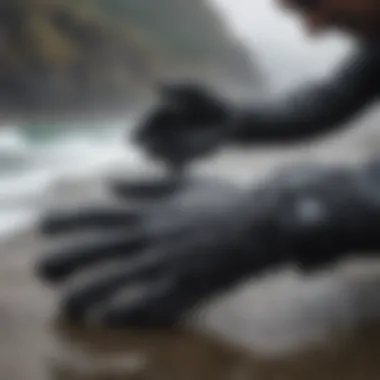
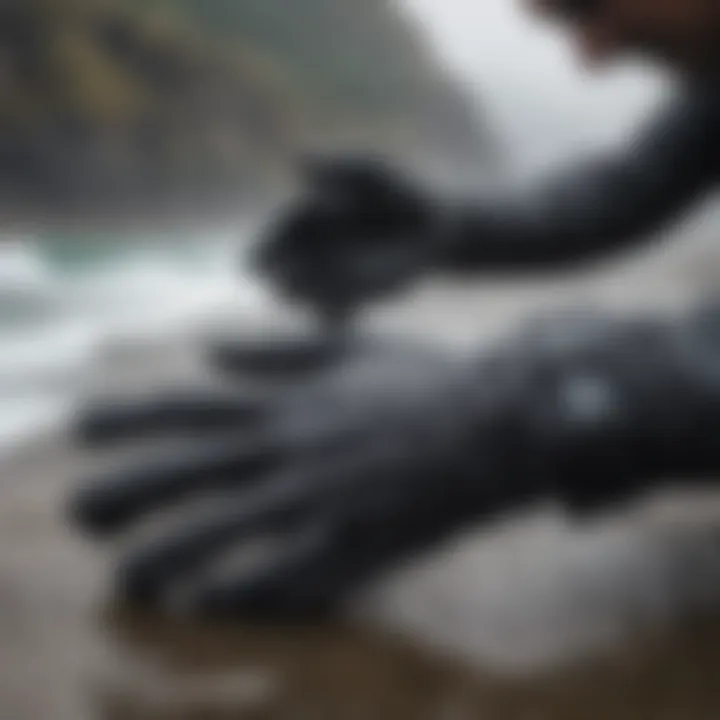
Types of Neoprene
Neoprene is the most common material used in surf gloves, and for good reason. It comes in various types, each with unique properties. The two primary types are:
- Standard Neoprene: This general purpose neoprene is effective at insulation, providing enough warmth for moderately cold waters. Its performance is satisfactory but can lack in durability over time, especially with frequent use.
- High-Quality Neoprene: Often labeled as limestone-based neoprene or super stretch models, these offer enhanced flexibility and warmth. They are typically lighter and provide better heat retention, making them ideal for surfers seeking extended wear in frigid conditions.
Choosing the right neoprene can lead to a more enjoyable experience. For instance, high-quality neoprene has a soft texture that hugs the skin, reducing the feeling of bulkiness while improving dexterity.
Importance of Stretch and Flexibility
Stretch and flexibility are crucial when it comes to the performance of surf gloves. When your hands are in the water, you want to maintain a firm grip on your board while paddling. Tightly fit gloves that don’t stretch well can actually hinder your performance, leading to hand fatigue on long rides.
- Dexterity: A glove with high stretch tends to allow better finger mechanics, which is important when gripping tiny surfboard rails.
- Comfort: Flexibility in gloves can enhance overall comfort during use; constraining materials can lead to cramping or discomfort, disrupting the experience.
Soft, flexible gloves also allow surfers to feel the nuances of the board, which is key for balance and control. You might hear surfers say, "If your hands are happy, you’ll surf better," which summarizes the significance well.
Durability Considerations
Durability is another critical aspect of material choices in surf gloves. You want gloves that can withstand the rigors of surfing—think sharp reefs, abrasive surfaces, and the daily wear and tear of saltwater exposure.
- Reinforced Areas: A quality pair of gloves will have reinforced sections, often around the palm, that can stand up to repeated friction without compromising performance.
- Longevity of Materials: Neoprene that retains its elasticity over time is vital. After all, rotting seams and fraying fabrics aren't just unsightly, they can drastically reduce the glove's effectiveness.
- Care and Maintenance: Even high-quality materials need proper care. Rinsing gloves with fresh water after each use can significantly extend their lifespan.
"Investing in high durability materials is like buying peace of mind for every surf session. You’ll spend less time replacing gear and more time enjoying the waves."
In summary, understanding the material choices for 7mm surf gloves can make all the difference in comfort, performance, and enjoyment in the water. Look for neoprene that balances warmth, stretch, and durability to find the best fit for your cold-water surfing adventures.
Design Features of 7mm Surf Gloves
When it comes to surf gloves, especially those with a thickness of 7mm, the design elements are critical. These features not only enhance performance but also ensure that the wearer remains comfortable while battling the elements. Using the right design features can mean the difference between feeling cozy and enduring a frigid session out on the waves. This section focuses on three key aspects of design: fin-sealing techniques, grip technology, and wrist seals, each playing a unique role in overall performance and user satisfaction.
Fin-Sealing Techniques
One of the standout design features of 7mm surf gloves is the fin-sealing technique. This is the method by which the seams of the gloves are constructed to minimize water entry. A well-sealed fin reduces water flow, thus helping maintain warmth while you’re submerged in cold waters. Brands may utilize various methods, such as glued seams or blind stitching, to enhance water resistance.
- Glued seams offer better waterproofing than traditional stitching, as they literally bond the material together.
- Blind stitching involves stitching only through the outer layer of the glove, leaving the inner layer intact, which serves to prevent water seeping through.
Ultimately, effective fin-sealing not only keeps surfers toasty but also enhances their overall experience by reducing distraction from cold water entering the gloves. This attention to detail makes these gloves a sustainable choice for someone who spends many hours in the ocean.
Grip Technology
Grip is another significant factor in the performance of 7mm surf gloves. The right grip technology ensures that surfers maintain a firm hold on their gear, which becomes increasingly important when facing choppy waters. Different design features contribute to grip, including textured palms and finger patterns.
- Textured surfaces add friction, making it easier to grasp a surfboard or any equipment securely.
- Finger profiles can also be tailored to fit the contours of your hands better, which adds to overall control.
Surfers often underestimate the importance of grip. Poor grip can lead to accidents, not to mention a frustrating riding experience. Therefore, investing in gloves that incorporate advanced grip technology is a no-brainer for serious water sports enthusiasts.
Wrist Seals and Their Importance
Wrist seals on 7mm surf gloves perform dual roles. They trap warmth while acting as protective barriers against water intrusion. A snug wrist seal will ensure that water won’t flow in, even when the surfer’s hands are submerged for a longer period. The fabric and construction here matter a great deal.
- Comfortable yet snug wrist seals made from flexible materials can adjust to different arm sizes while still providing a barrier against chilly water.
- Adjustability features, like Velcro straps, allow surfers to customize the fit according to personal instruction, which can dramatically enhance comfort levels.
To sum up, good wrist seals can pave the way for a much more enjoyable surfing experience, freeing you from having to constantly shake off cold water. This design feature may seem minor, but it plays a significant role in keeping surfers focused on their performance rather than their discomfort.
In closing, the design features of 7mm surf gloves substantially influence a surfer’s experience in colder waters. Without a doubt, when selecting the right pair, it pays to consider fin-sealing techniques, grip technology, and dependable wrist seals. These elements are not merely technical specifications; they are fundamental benefits that can significantly affect performance and enjoyment.
Evaluating Fit and Comfort
Evaluating fit and comfort in 7mm surf gloves isn't just about slipping your hands into them and heading to the waves. It plays a crucial role in your overall surfing experience. Well-fitted gloves can mean the difference between a successful surf session and a battle against the cold water. Tight gloves restrict movement, while ones that are too loose can let in frigid water, nullifying the benefits of their thickness. Thus, finding that sweet spot of fit is paramount.
Sizing Guidelines
When it comes to sizing, understanding manufacturer charts is vital. Each brand can have its own sizing system, which may not align perfectly with others. A good rule of thumb is to measure your hand size by following these simple steps:
- Width: Measure across your palm at its widest point.
- Length: From the tip of your longest finger to the base of your palm.

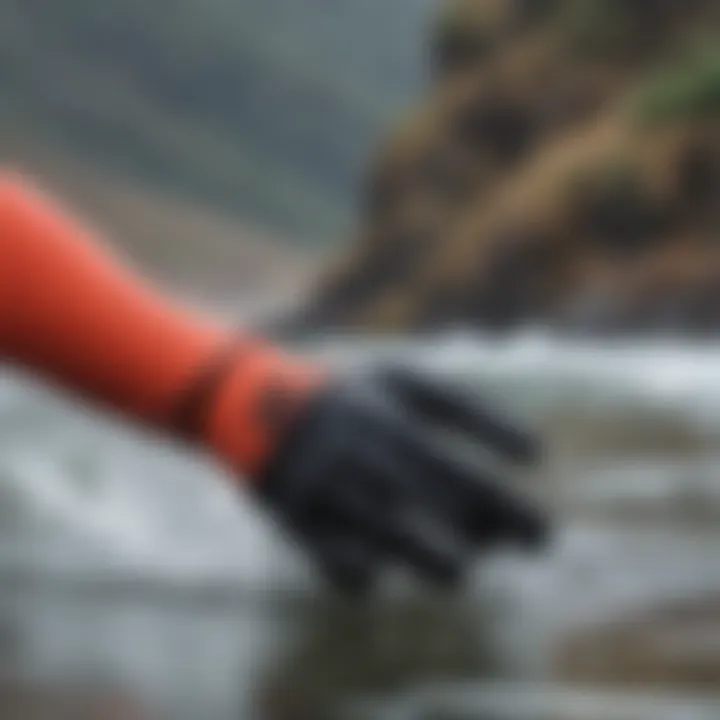
Once armed with these measurements, refer to the specific glove brand's sizing chart. A snug fit ensures that the material sits tight against your skin, providing the best insulation. But remember, it shouldn't be so tight that it cuts off your circulation. This is the balancing act surfers must master: fit that is snug but accommodating enough for freedom of movement.
Assessing Comfort During Use
Comfort in use comes down to several factors beyond sizing. It's important to consider the actual feeling of the glove during a session. Pay attention to:
- Material Touch: The neoprene should feel soft against your skin, not abrasive.
- Flexibility: The glove should allow full finger movement without causing strain or stiffness.
- Wrist Feel: Can you comfortably move your wrist? Over time, discomfort can turn into pain, which isn't ideal when you're focused on catching the next wave.
Many surfers recommend testing gloves in water before making a commitment. Keeping them on for longer periods will provide insights on how they perform, especially in terms of warmth and flexibility.
Adjustability Options
What makes a glove adaptable to varied conditions? It’s about features that allow adjustments. Some gloves come with reinforced wrist straps or cinches that let the wearer tailor the fit more closely around their wrists. This feature can significantly improve the likelihood of a secure seal against water entry.
Additionally, check if the gloves offer sectional flexibility; in other words, does the glove allow for finger extension while keeping the palm snug? A design that accommodates movements enhances comfort levels while paddling or popping up on the board.
"In the world of surfing, where comfort meets functionality, finding the right fit can elevate your entire experience."
In summary, evaluating fit and comfort is not just a checklist item; it’s a vital part of preparing for chilly surf conditions. Make sure to take the time to investigate sizes and comfort levels so you can focus fully on enjoying the ride.
Performance Aspects of 7mm Surf Gloves
When it comes to tackling those chilly waves, the performance of your surf gloves can be a game-changer. It's not just about keeping warm; it’s equally about how they perform under pressure, especially in cold water. Understanding the key elements called performance aspects can make a surfer's experience noticeably better. Let’s dig into the nuances of heat retention, waterproofing, and flexibility.
Heat Retention Mechanisms
The first thing that comes to mind with 7mm surf gloves is their ability to trap heat. The thicker the glove, the more insulation it provides. But how does this process truly work? The key lies in the material's thermal properties and overall design.
7mm gloves utilize high-quality neoprene which does more than just keep the cold water at bay. Many gloves have an inner lining made from materials like fleece or titanium. These linings create a barrier that reflects back body heat, ensuring those precious degrees don’t escape.
Moreover, some designs incorporate ’nano technology’ that fills the small air pockets within the material, enhancing insulation. On top of that, good fit is critical; gloves that fit like a second skin reduce cold water intrusion, ultimately preserving warmth. When shopping for gloves, be sure to evaluate their heat retention features. You don’t want to be left shivering after a long session!
Waterproofing Capabilities
Waterproofing is another major component of performance. After all, if the gloves aren't keeping the water out, what's the point? A solid 7mm surf glove should have near-total impermeability to keep your hands dry as you paddle out.
Most gloves have a combination of sealed seams and unique closures. Two types of seams often come into play: glued and blind-stitched seams. The blind-stitching technique does an admirable job at creating a watertight seal. With this technique, the stitching goes through the outer layer, preventing leakage.
Also, the wrist seals matter a lot here as well. A snug wrist seal stops water from pouring in with every wave, maintaining that sought-after dry feeling during your surf session.
Flexibility in Cold Conditions
Flexibility may sound less crucial compared to warmth and waterproofing—but in reality, it's an integral piece of the puzzle.
Surfers need to maintain dexterity for paddle movements and grip on the board. A glove that is too thick or tight can feel restrictive and can affect performance. So, how can you ensure flexibility? Look for gloves designed with flexible neoprene compounds. Many brands now use specialized stretches designed to provide warmth without compromising movement.
Furthermore, gloves featuring pre-curved fingers allow for a more natural grip. This aspect is just as important as heat retention; if you can’t control your board, all that insulation won’t do you any good.
Care and Maintenance of Surf Gloves
Proper care and maintenance of surf gloves ensures that they remain functional, comfortable, and durable for many surfing sessions. High-performance gear, like 7mm surf gloves, needs attention to retain features that enhance the surfing experience in cold waters. Neglect can lead to deterioration, compromising both warmth and flexibility, which can be a game changer in chilly conditions. Thus, understanding how to clean, store, and repair these gloves is essential for those who wish to maximize their lifespan and effectiveness.
Cleaning Techniques
Cleaning surf gloves might seem trivial, but it’s actually foundational for their upkeep. After those exhilarating sessions, rinsing them in fresh water is crucial. Saltwater and sand can be corrosive and cause wear over time. Here’s how to do it effectively:
- Rinse immediately: After taking off your gloves, rinse them under cold, running water to wash away any remnants of salt or sand. Letting them sit with debris can worsen damage.
- Use mild soap: A gentle soap can help cut through oils and grime. Look for products specifically designed for neoprene or rubber, as these won’t degrade the material.
- Air dry: Never use direct heat sources to dry the gloves. Hang them in a shaded area to maintain flexibility and shape.
"Keeping your gloves clean is like keeping a good relationship; it requires regular attention and care to keep things running smoothly."
Storage Recommendations
Storing your surf gloves properly can extend their life significantly. Here are some pointers to consider for effective storage:
- Keep them dry: Ensure that your gloves are completely dry before storing to prevent mold and mildew. Always store gloves in a cool, dry spot away from direct sunlight.
- Avoid folding: It’s tempting to crumple your gloves into a gear bag, but this can create creases that compromise their fit and insulation. Instead, lay them flat or hang them to retain their shape.
- Minimal pressure: When stacking or storing in tight spaces, be conscious that heavy items on top might deform the gloves. Keep them in a designated spot where they have room to breathe.
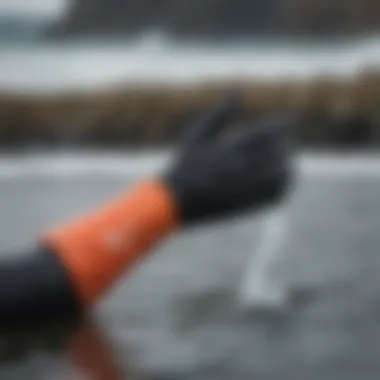
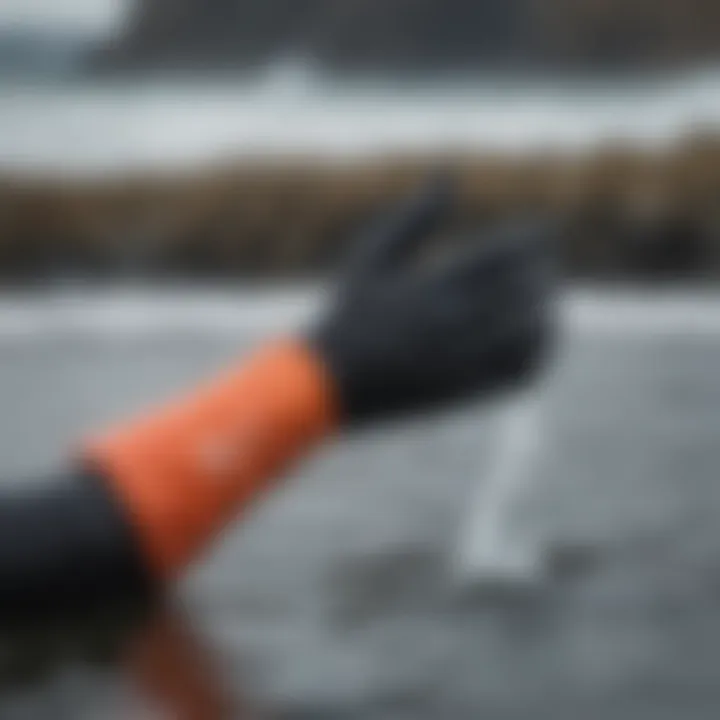
Repairing Minor Damage
Even with the best care, damage can occur. Understanding how to repair your gloves can save you money and prolong their lifespan:
- Patch kits: Many brands offer repair kits specifically for their gloves. These generally include neoprene patches and adhesive designed for underwater repairs.
- Seal small tears: For minor punctures or tears, a small application of repair adhesive can seal the deal. Make sure the area is clean and dry before applying.
- DIY solutions: In instances where a patch kit isn’t available, using strong silicone adhesive can work in a pinch for small repairs. Just ensure it's suitable for rubberized materials.
By adopting these care and maintenance practices, surfers can enhance their overall experience in colder waters. Charged with the knowledge of how to keep gloves in top shape, any surfer can enjoy many more waves without the worry of losing essential warmth and dexterity.
Potential Alternatives to 7mm Surf Gloves
When considering surf gear for colder water conditions, many might gravitate towards 7mm surf gloves. However, it’s smart to explore alternatives too. Different situations, preferences, and body types can influence one’s choice. Knowing these alternatives can enhance your surfing experience, offering options that may better suit specific needs.
Using alternatives could provide not only warmth but also improved flexibility and mobility. If 7mm seems too thick for certain conditions, alternatives might help keep fingers nimble while still protecting hands. It's all about finding that sweet spot where comfort meets functionality.
Shorter Thickness Gloves
Shorter thickness gloves are often the go-to choice for surfers who might feel bogged down by heavier options. Typically available in thicknesses of 3mm to 5mm, these gloves can offer adequate warmth for milder cold waters, particularly in transitional seasonal temperatures.
For instance, when spring starts to thaw winter’s chill, surf gloves with this range of thickness can be just right. They’re lighter, allowing for greater hand mobility, which can be critical during those need-to-paddle moments. It can make a big difference when you're trying to catch that perfect wave and need quick hand movements.
Moreover, short gloves can provide decent grip and tactile feedback, helping surfers with board control. This also works well when you need to swap your leash or make adjustments mid-ride while maintaining warmth.
Hand Warmers and Accessories
For those who prioritize warmth but want to steer clear of thicker gloves, hand warmers may be the answer. These small devices can easily fit inside gloves or mittens, offering significant heat without the added bulk. Available in both disposable and reusable options, hand warmers can provide that extra boost when needed during chilly sessions.
Besides hand warmers, accessories such as wrist warmers and thermal liners can also play a role. Here’s why they’re valuable:
- Wrist Warmers: These can help keep heat from escaping, complementing your gear without weighing you down.
- Thermal Liners: These can fit under a regular glove, adding another layer of insulation without the need for a full-coverage 7mm glove.
- Neoprene Totes: Carrying extra gear in a neoprene tote ensures accessibility wherever you go, allowing for quick replacements if water seeping might occur.
In essence, the decision to explore alternatives to 7mm surf gloves opens up a world of possibilities. By understanding and weighing these options, surfers can tailor their gear to suit personal comfort levels and surf conditions, ensuring a more enjoyable time out on the waves.
"The right gear can make all the difference between an exhilarating surf session and a memorable struggle against the elements."
User Experiences and Feedback
When it comes to choosing the right 7mm surf gloves, users' experiences and feedback play a vital role. The real-life stories and opinions collected from surfers give invaluable insights into the performance and practicality of these gloves. Not only can these narratives highlight what works well, but they also shed light on common pitfalls, helping prospective buyers to make informed decisions. The subjective nature of personal remarks allows for considerations beyond mere specifications, encompassing comfort, usability, and fit in real-world conditions.
Common Praises and Complaints
Listening to the voices of those who have braved the waves can illuminate a lot. Many surfers rave about how well their 7mm gloves perform in frigid waters. Some stick out common praises:
- Heat Retention: A number of users emphasize how fortunate they feel with the warmth these gloves provide. Ratings soar high when surfers find their hands still toasty after a long session.
- Grip: Surfers often commend the grip technology, saying it feels secure and reliable, allowing for more confidence when navigating tricky conditions.
- Flexibility: Flexibility tends to be a huge winner among users. They appreciate the balance between warmth and the ability to move their fingers freely, making paddling less of a chore.
On the flip side, complaints do pop up occasionally. A common gripe among some users is:
- Sizing Issues: It appears that sizing can be tricky. Many find themselves between sizes, leading to discomfort, especially when surfing for extended periods.
- Wear and Tear: While most surf gloves show durability, a handful of users mention that after several sessions, they start to notice wear, particularly in areas that face heavy use.
Real Life Use Cases
Let’s dive into some real-life scenarios featuring 7mm surf gloves, showcasing how these gloves integrate into a surfer’s routine and enhance their experience.
- Winter Surfing in the Pacific Northwest: Surfers battling chilly December waves often speak glowingly about the durability and heat retention of their 7mm gloves. They describe feeling the icy bite of the waves, only to find their hands remaining warm and functional throughout a two-hour session.
- Long Surf Sessions in New England: Many East Coast surfers highlight how they appreciate the flexibility of their gloves during lengthy outings. A surfer noted that the ability to hold on tight to their board without fumbling around has made sessions of over three hours manageable, even in colder temperatures.
- Performance in Storm Conditions: Surfers frequently face tumultuous weather conditions, where having reliable gear becomes paramount. Users point out that their 7mm gloves stayed solid even amidst strong currents and wind-chill, allowing them to focus on riding the waves instead of worrying about their gear.
"My hands were warm and agile, allowing me to surf without constantly checking if they were freezing up," one surfer highlights in their review.
These insights echo the overall sentiments regarding the practical side of wearing 7mm surf gloves, emphasizing that real-world experiences often confirm or contradict product claims made by manufacturers. Knowing what fellow surfers cherish or contest about these gloves can definitely steer the undecided ones in the right direction, further enriching the decision-making journey.
Culmination on Choosing 7mm Surf Gloves
When it comes to selecting the right pair of surf gloves, especially in the realm of 7mm options, understanding the nuances can make all the difference. Cold water surfing demands specific gear, and while a lot of folks might rush into a purchase based solely on brand names or price, the decision should really hinge on a more holistic view of the elements that contribute to a quality experience in the water.
Factors to Consider
- Thickness vs. Flexibility: 7mm gloves are meant to provide optimal warmth, but they should not compromise your dexterity. It's vital to strike a balance. Consider how thick the fingers are as opposed to the main body of the glove.
- Material Quality: Neoprene varies widely. High-quality neoprene not only offers better insulation but also allows for more movement, making it easier to handle your board. Look for suits branded with terms like "super-stretch" or these that feature reinforced areas for added durability.
- Wrist Sealing: None of that frigid water seeping in! A strong wrist seal can mean faster swims and longer sessions without discomfort. Test the elasticity and snugness before making a commitment.
- Grip: The ability to maintain a grip on the board is fundamental to surfing, especially when battling waves. Gloves with textured palms provide better tactile feedback and a sense of control.
- User Feedback: Always do a bit of digging before a hefty purchase. Reading reviews, feedback from other surfers, and experiences from forums like reddit.com can provide insights that you wouldn't find on the packaging.
Final Recommendations
In the end, investing in the right 7mm surf gloves can enhance your surfing experience immensely. Here are some final pointers to consider:
- Try Before You Buy: If possible, get a feel for the gloves in-store. They'll either fit like a glove or like a sack of potatoes. It's better to know before you head into the water.
- Stay Updated On Recent Reviews: The market for surf gear constantly evolves. Just because a brand was top-tier a year ago doesn't mean they still hold that status. Review platforms and social media can shed light on the latest trends.
- Be Wary of Pricing: While it's tempting to snap up any gloves on sale, remember—sometimes you get what you pay for. An expensive pair may seem steep but can pay off in terms of reduced discomfort and increased performance over time.
- Maintenance is Key: Don’t overlook the care of your gloves. The longer you keep them in top shape, the better they’ll serve you on those chilly mornings riding the perfect wave.
Choosing the right 7mm surf gloves isn't just about keeping your hands warm; it comes down to optimizing your ride, enhancing your performance, and ensuring that your time spent in the water is as enjoyable as possible. So, keep these factors in mind, do the due diligence, and ride the waves confidently.











